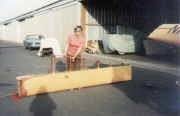
DEEP PURPLE DREAM
by Doris E. Loftsgaard
When I earned my Pilot's License in 1968, it was an answer to a childhood dream. Along with that, my husband, Ben, and I could get away on weekends while we were working. Then we met Dale Beach and his family. He introduced me to EAA. To make sure I attended the meetings he would pick me up at our house and take me to the meetings. There I met Dale's son, Andy and his friend, Bob Belk. I also met Jesse Johnson and his wife. Ben and I became friends with them when we bought a pick-up and camper from him before he and his wife moved to Alaska. We had many delightful short trips with that rig.
One night when Ben and I were at a hanger party at Executive Airport in Sacramento we saw Jesse. He asked me to fly to Oakdale with him the next day to look at a 'tail dragger' he planned to buy and fly back to Alaska. I thought that was a great idea. After we left Oakdale Jesse thought it would be nice to go to the Fly-in at Rio Vista. When we got there, we saw Bob and Andy and joined them to walk down the line of airplanes with them. A beautiful pink Mooney Mite was parked in the line. A lady owned and flew it and, if I remember correctly, had named it "Pink Lady".
That was it! That is what I wanted. I began thinking: If Ben couldn't go along, I could go out flying for less money (?) than I was paying for the Cessna 150 I was flying. I dreamed about flying my own little Mite. One of my favorite songs of the day was "Deep Purple". (Ben still remembers the words). I would paint my airplane purple and call it my "Deep Purple Dream".
 |
Ben and I owned our own publishing business. It was new and we were struggling to build it up, so money for flying wasn't always available. When I was asked to work at the City Building Inspection Department while a couple of regular employees took maternity leave, I was delighted. Ben found a high school student to do my work at our office while I was gone. This is where I met Bill Clark, a newly hired electrical inspector from Detroit. Other inspectors told me he was a pilot and I'm sure they told him I was also a pilot. One day when we crossed paths at the office we stopped to introduce ourselves and that evening we went flying. One day in 1976 Bob Belk called me and said, "Doris, guess what we found for you. a Mooney Mite! A fellow by the name of Rodriguez has it in his garage. It needs a lot of work (an understatement!) he wants $1,500, maybe he will take less." We wondered at the time how he got a Mooney Mite in his garage.
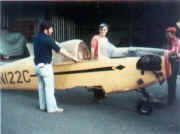 |
I was making a little extra money working at the City, so when I asked Ben if I should buy it he said, "Sure, go ahead."
Before I made a move I called Doc Sanderson, a Mooney Mite owner whom I met at EAA. He was very kind and helpful. We had a long talk, he answered my questions and gave me information I needed to make my decision.
Bob Belk owned an auto repair garage and offered to let me store the plane
in his shop and work on it whenever I had time. He had a pick-up so off the
three of us went to 'grab' this prize before someone else heard about it. We
went, to see Mr. Rodriguez and, sure enough, all the parts of a Mite were in his
garage. The wing was cut into two pieces and was hanging on the wall. I bought
all the pieces of the aircraft and, after a couple of trips, we had them all
back at Bob's shop. Later we found out what happened to the wing.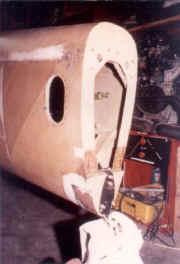
[This is how I remember the story. One day after I started on the project I went to Capitol Sky Park to get some parts and I got a first hand report of the incident from a fellow named Ivan who worked there. He said that after Mr. Rodriguez had paid someone to re-cover the wing an inspector found some dry rot in the main spar. His efforts to have the man who did the work on the wing repair the dry rot fell on deaf ears and he was furious. He went home and came back to the airport with a flat bed trailer behind his car. Ivan asked him what he was going to do with it. The reply was "I'm going to take my plane home." Ivan told him the wing was too big for the trailer and he couldn't drive down the street with it on the trailer.
Rodriguez said, "Watch me," and promptly went out, started his chain saw, and cut the wing off at the root. Then he piled the whole thing on his trailer and went home.]
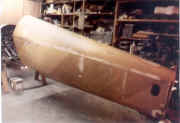 |
It wasn't long before Bob and Andy started scouting for someone who could rebuild the wing. They found someone south of Lodi who was certified to do repair on airplanes and we went down to see him. He said he could do the job and it would probably cost between 1,000 and 1,500 hundred dollars. We thought long and hard on that one.
Then, another fellow from EAA told them that there was a new Mite wing at Columbia airport that we might be able to buy. The price was $1,500. I don't remember the name of the fellow who built it, but his aircraft repair shop was at the airport. He had built the wing for someone who had bought the wrecked plane from the owner. At one time the Mite had been owned by Dallas Christian of Reno Air Race fame. He sold it to a student of navigation at Mather Air Force Base near Sacramento. The fellow took it to Phoenix Field at Fair Oaks, CA for his first flight, stalled on take off, and crashed into the fence. The plane was demolished. Someone bought what was left of the aircraft and took it to Columbia Airport where they had the wing built. Who ordered the four extra inches on each wing-tip will probably remain a mystery. After the wing was completed, the person who owned the Mite decided not to re-build it and it hung on the wall of the repair shop for some time.
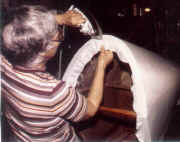 |
Ben and I borrowed a houseboat trailer and went up to Columbia, bought the wing, and brought home our prize. Bob Belk said I could hang it in his shop, so after I did my chores at the office I would go there to work on the wing. I learned how to sand and how to handle polyurethane. There was no place in the wing spar to attach the landing gear spring so Bob, using the old wing as a pattern, had me cut a slot the exact size we needed for a hardwood insert. I got some aircraft cement and, following FAA regulations, secured it in place. Bob said I had done an excellent job.
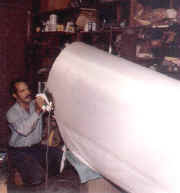 |
All this time we had the fuselage in our garage at home. I worked on the horizontal stabilizer in our living room. (I knew airplane builders who couldn't get away with that in their own home.) With some advice from members of EAA I learned how to prepare the plywood for cover. Larry Lombard, also in EAA, was building a VariEze and I offered him help now and then. He was a good source of information. He told me about micro-balloons to fill in the low spots on the plywood body and I found the material at a model airplane shop.
I asked Bill Clark to come to our house one evening a week to work on the plane with me. After thinking about it for a while he said he would do it. One night when we were mixing the micro-balloons with half-and-half epoxy we didn't get quite the right measurement of the two parts. The next morning the mixture on the side of the fuselage was just as gooey as when we had applied it. I scraped it off and applied another batch. It dried properly, but fell off the fuselage in one chunk. I went into panic mode for two or three days. Then I got smart and called the young man at the model shop and asked him what to do. He said he would try to find out for me and call me right back. I really didn't believe him, but he called in about ten minutes and told me to use acetone and a heat lamp to remove the residue. I asked him who he spoken to and whether or not I could call this person.
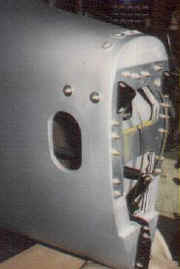 |
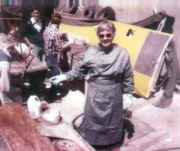 |
He said, "Ya, he's my Dad. His name is Bill Robinson and he's an instructor at Sacramento City College Aeronautics department." Wow! What a stroke of luck! I called Bill Robinson. He asked me many questions and the two of us went through the whole project to date on the phone. He said if I ever needed help again to call him. I still can't believe how fortunate I was to have him say that. Without his help, that plane would still be sitting in our garage or sold for a pittance to someone else.
Bill Clark and I continued to work on the fuselage. We applied the Dacron and ironed it on. I sprayed the under coat, etc. My husband, Ben, bought a portable hanger at Rio Linda Airport and we stored the wing there. When I covered the thin metal elevators with Dacron, the iron got a bit too warm and it pulled the Dacron too tight over the metal frame. When I tried to install the frame onto the horizontal stabilizer it didn't fit properly. I went right to the phone and called Bill Robinson and told him my plight.
He said, "Can you bring the parts down to the school?"
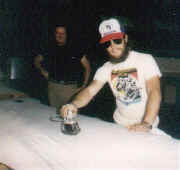 |
Oh! Happy day! I secured the two elevators on top of my little Datsun and headed for the College. When I walked into the Aeronautics lab with those elevators all of the students descended on them like flies on honey. They must have thought those things were toys. When Bill Robinson saw the reaction of his students, he arranged for me to participate in a school program which allowed me to bring the disassembled aircraft into the City College Aeronautics Department where it could be used as a teaching tool. This program would allow me to work on the airplane too.
Ben and I went to Travis Airbase where we met Ken Swain. He was in the Airforce and piloted the huge C-141's. He was also a member of EAA and had built his own VariEze. We borrowed his flat-bed trailer and
 |
transported the fuselage and the wing to the college. There, each afternoon I was able to participate in the project. The engine went into another room where aircraft mechanics was taught. Walt Kuhn, the instructor there asked me to take the cylinders of the 65 hp Continental engine to a shop in Oakdale CA to have them magna-fluxed. Later, when I picked them up, I was told that the "jugs" were in great shape and needed very little work.
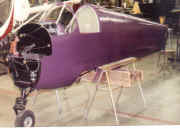 |
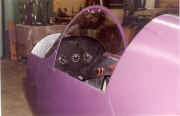 |
About a year later the project was ready for assembly. A number of people who saw the completed project were puzzled by the purple paint job and I was often asked, "Why purple?" to which I replied, "This little Mooney Mite is my Deep Purple Dream." I applied for and was issued a new aircraft identification number. The Mite was manufactured in 1950, my age at the time was 50, and my initials are DL, so. I chose N50DL. Before it was moved from the College lab I fixed a huge "Thank You" lunch for Bill Robinson and the students in the class. Bill Clark, Ben and I joined them. I learned that there was a good possibility that I could get the Mite into the College hanger at Executive Airport where it would be assembled and tested. A donation to the Student Flying Club was all it took. Dennis Noble was the instructor and the students there had a field day with that little "toy". I dropped by once in a while to say "hi" and watch the students having a great time with it.
 |
 |
In 1983 it was ready for a test flight. I heard about Lee Taylor who was a flight instructor and test pilot. When I contacted him and asked him if he would test my newly re-built Mite, he said he would be glad to do so.
The first test flight was scheduled to take place in December 1983. Lee aborted his first take-off because the airspeed indicator was not working. On inspection someone found a lone, dead spider clogging the air intake. A second attempt was also scratched when Lee saw a drop in oil pressure. One of the oil lines had developed a leak so, once again, the Mite returned to the hanger.
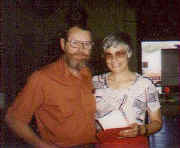 |
A few days later we all returned to the airport and watched the first test flight of "My Deep Purple Dream". Lee took off, climbed to 1500 feet and circled the airport for a few minutes while he put the little plane through its paces. When he landed he said, "Let's take this baby home," meaning the hangar at Rio Linda.
Some time later Lee flew the plane to an old military airport in Yolo County where student pilots went to practice landings. Doc Sanderson flew in with his Mite and I drove over. I told Lee I wanted only to do some taxi runs down the runway. Even though he said, "No Doris, you have to fly the plane," I did not intend to do so.
The first thing I discovered was that I was unable to prop the engine. I climbed into the cockpit and Doc tried to prop it. He too was unable to turn it over. His comment was that it had "great compression". Finally Lee took over and propped the engine. It started and I taxied over to the runway. I intended to taxi up the runway, turn back and do it again.
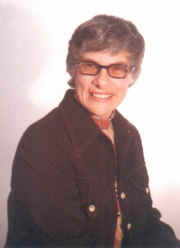 |
It was difficult for me to operate a left-hand throttle instead of the right-hand throttle I was used to in the Cherokee I had been flying. On my second taxi run the little thing took off on me. I knew I didn't want to try to practice landing from twenty feet in the air so I decided to go on up to 1500 feet and see how it worked. After my knees stopped shaking I decided to try a landing. On my first approach to land I learned that the Mite did not want to come down as quickly as the Cherokee I was used to. It wanted to keep flying. After a bounce or two I finally landed. At that time I decided to continue flying long enough to complete three take-offs and landings. I was proud of the last one... it was better than the first two. Doc, Lee, and I celebrated by going to a Restaurant north of the airport and having lunch.
Several months later we went to an air show at Truckee, CA. There we met John Burton, one of the students at City College who had worked on the plane. I suggested that he fly his plane to Rio Linda and fly the Mooney Mite back to the air show at Truckee. When he arrived back he taxied in with a huge smile on his face. While the Mite was on display, a group of students who had worked on re-building it gathered around it and showed it to their friends. As they admired their handiwork they could be heard saying, "See that tail section. propeller, paint job, etc., I did that!"
Before the weekend was over, John enjoyed several more trips around Lake Tahoe. Then I did a couple of take-offs and landings and flew around the countryside. It was wonderful flying around the Truckee area. That was the last time I flew my "Deep Purple Dream."
August 16, 2001